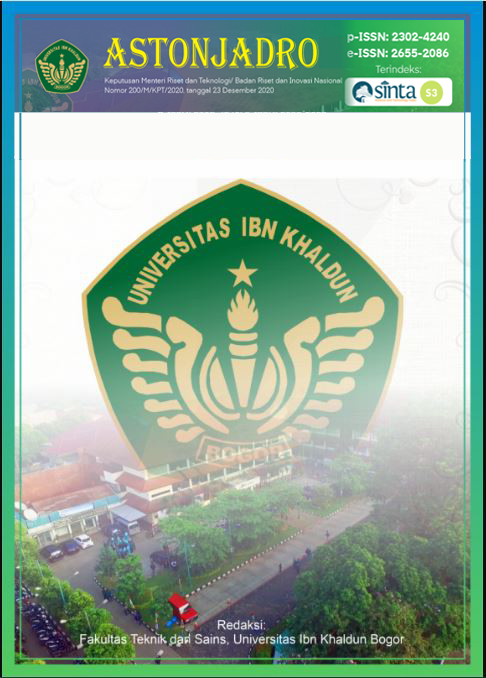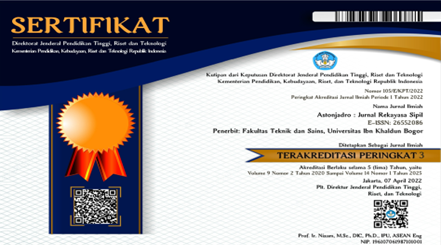Analysis of Upstream Citarum Watershed Flow Using Semi-Distributed Hydrology Model with SWAT
DOI:
https://doi.org/10.32832/astonjadro.v14i1.16510Keywords:
discharge; SWAT; Watershed; NSE; upper citarum watershed.Abstract
The large conversion of forests’ areas that have a significant spatial impact on the area causes an increase in annual sediment rates that exceed 100 tons/km2. This build up of sediment has the potential to reduce the rivers capacity to handle large intensity rainwater. This research aims to find out how reliable the Semi-Distributed model with the Soil and Water Assessment Tool (SWAT). The SWAT model is when applied to the Upper Citarum watershed (UCW). The results of simulations carried out for one year showed a maximum flow discharge of 441 m3/sec and a minimum flow discharge of 2.15 m3/sec. However, based on existing water estimation post data, the maximum observed discharge value is 460 m3/sec and the minimum observed discharge is 4.06 m3/sec. After calibrating the discharge from the simulation results of the SWAT method with the observed discharge, we obtained quite good results with NSE value > 0.56, which value indicates that the SWAT model has good results. Meanwhile, the R value ≥ 0.79. In other words, the SWAT method of flow discharge modeling can be applied and can be one of the method choice for generating discharge in the UCW.
References
Akoko, G.; Le, T.H.; Gomi, T.; Kato, T. A Review of SWAT Model Application in Africa. Water 2021, 13, 1313. https://doi.org/10.3390/w13091313
Asdak. 2014. Hidrologi dan Pengelolaan daerah Aliran Sungai. Gajah Mada University Press. Yogyakarta.
Diah Ainunisa, Gusfan Halik, dan Wiwik Yunarni (2020),” Pemodelan Perubahan Tataguna Lahan Terhadap Debit Banjir Das Tanggul, Jember Menggunakan Model SWAT (Soil and Water Assessment Tool)’, Rekayasa Sipil / Volume 14, No.2 – 2020 Issn 1978 – 5658
Harto, Sri. 2000. Hidrologi; Teori, Masalah, dan Penyelesaian, Nafiri Offset,Yogyakarta.
Jacques, St, J.-M.; Sauchyn, D.J.; Zhao, Y. Northern Rocky Mountain streamflow records: Global warming trends, human impacts or natural variability? Geophys. Res. Lett. 2010, 37, L06407.
Janjić,J.;Tadić, L. Fields of Application of SWAT Hydrological Model—A Review. Earth 2023, 4, 331-344. https://doi.org/10.3390/earth4020018
Jan Sitterson, Chris Knightes, Rajbir Parmar, Kurt Wolfe, Muluken Muche, Brian Avant,” An Overview of Rainfall-Runoff Model Types”, EPA Report Number September 2017
Khadka, Dibesh, Mukand S. Babel, and Ambili G. Kamalamma. 2023. "Assessing the Impact of Climate and Land-Use Changes on the Hydrologic Cycle Using the SWAT Model in the Mun River Basin in Northeast Thailand" Water 15, no. 20: 3672. https://doi.org/10.3390/w15203672
Kim, Da Ye, and Chul Min Song. 2020. "Developing a Discharge Estimation Model for Ungauged Watershed Using CNN and Hydrological Image" Water 12, no. 12: 3534. https://doi.org/10.3390/w12123534
Khuzaimy Rurroziq, Gusfan Halik, Entin Hidayah (2020), Analisis Perubahan Tata Guna Lahan Terhadap Debit Banjir Sub-Sub Das Keyang-Slahungtempuran (Kst)” Teras Jurnal, Vol 10, No 2, Sep 2020, DOI: http://dx.doi.org/10.29103/tj.v10i2.309
Kibii, J.K.; Kipkorir, E.C.; Kosgei, J.R. Application of Soil and Water Assessment Tool (SWAT) to Evaluate the Impact of Land Use and Climate Variability on the Kaptagat Catchment River Discharge. Sustainability 2021, 13, 1802. https://doi.org/10.3390/su13041802
Lufi, Suryaningtyas & Suhartanto, Ery & Rispiningtati, Rispiningtati. (2020). Hydrological Analysis of TRMM (Tropical Rainfall Measuring Mission) Data in Lesti Sub Watershed. Civil and Environmental Science. 003. 018-030. 10.21776/ub.civense.2020.00301.3.
Manggala Anindyaguna, Suharyanto, dan Teddy Tedjakusuma (2017),” Sedimentation Model In Citarum River And West Tarum River Branch And East Tarum River Branch”, Jurnal Teknik Lingkungan Volume 23 Nomor 2, Oktober 2017 (Hal .43-52)
Mohajerani, H.; Jackel, M.; Salm, Z.; Schütz, T.; Casper, M.C. Spatial Evaluation of a Hydrological Model on Dominant Runoff Generation Processes Using Soil Hydrologic Maps. Hydrology 2023, 10, 55. https://doi.org/10.3390/hydrology10030055
Olga Vigiak, Anna Malagó, Fayçal Bouraoui, Matthias Vanmaercke, Jean Poesen, 2015 ,,” Adapting SWAT hillslope erosion model to predict sediment concentrations and yields in large Basins’, Science of The Total Environment, Vol 538, pp. 855-875, https://doi.org/10.1016/j.scitotenv.2015.08.095.
Zexing Yu, Jiefeng Wu, Huaxia Yao, Xiaohong Chen, Yiqing Cai,’Calibrating a hydrological model in ungauged small river basins of the northeastern Tibetan Plateau based on near-infrared images, Journal of Hydrology, Volume 618, 2023, 129158, ISSN 0022-1694, https://doi.org/10.1016/j.jhydrol.2023.129158
Downloads
Published
How to Cite
Issue
Section
License
Copyright (c) 2025 ASTONJADRO

This work is licensed under a Creative Commons Attribution-ShareAlike 4.0 International License.
Paper submitted to ASTONJADRO is the sole property of the Astonjadro Journal. Unless the author withdraws the paper because he does not want to be published in this journal. The publication rights are in the journal Astonjadro.ASTONJADRO
LICENSE
This work is licensed under a Creative Commons Attribution-ShareAlike 4.0 International License.
Based on a work at http://ejournal.uika-bogor.ac.id/index.php/ASTONJADRO













